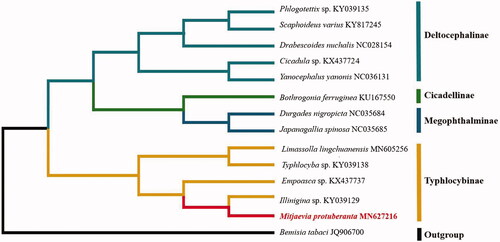Abstract
The complete mitogenome of Mitjaevia protuberanta (GenBank accession number MN627216) is 14,032 bp (AT: 77.43%) in length, including 13 protein-coding, 22 transfer RNAs, and 2 ribosomal RNAs. All protein-coding genes used ATN as initiation codon except ND5 that used TTG as initiation codon, and TAA, TAG, and T were termination codons. We constructed a phylogenetic tree from 14 species (Hemiptera) based on the nucleotide sequence of 13 mitochondrial protein-coding genes. The phylogenetic analysis results showed that mitochondrial genome of M. protuberanta had the same characteristics as other Cicadellidae species.
Mitjaevia protuberanta Song et al. (Citation2011) belongs to the genus of Mitjaevia, which currently consists of 17 known species around the world (Ghauri Citation1974; Song et al. Citation2011). Most of these leafhoppers often have dark spots on the body and are an important agricultural pest, which are widely distributed in the Palearctic and Oriental regions (Korolevskaya Citation1976). Recently, several investigators established different phylogenetic relationships for Typhlocybinae based on different molecular markers. However, further genomic studies have been hampered by the lack of information on the complete mitogenome of more genera and species form Typhlocybinae. In order to explore its phylogenetic relationship with other leafhoppers, we provide the complete mitochondrial genome of M. protuberanta (GenBank: MN627216). Adult specimens of M. protuberanta were collected from Fanjing Mountain, Tongren City, Guizhou Province, China (N27°53′, E108°47′). Samples (GZNU-ELS-2019003) have been deposited in the insect specimen room of Guizhou Normal University, Guiyang, China.
The total length of M. protuberanta mitochondrial genome is 15,472 bp. The circular mitogenome contains 13 protein-coding genes (PCGs), 2 ribosomal RNA genes (rns and rnl), 22 transfer RNA (tRNA) genes, and a 1416 bp long non-coding AT-rich region. The gene order and orientation of M. protuberanta were identical to those observed in other Cicadellidae mitogenomes (Luo et al. Citation2019; Wang and Xing Citation2019). The base composition of the genome is as follows: A = 40.01%, T = 37.43%, G = 10.63%, and C = 11.93%, and was biased toward AT (accounting for 88.50%). This mitogenome presented a negative AT-skew (0.033) and a positive GC-skew (–0.058). Twenty-three genes were transcribed on the majority strand (N-strand), whereas the others were oriented on the minority strand (J-strand).
The M. protuberanta mitogenome displays gene overlap in 48 bp in 12 locations, the longest 10 bp overlapping exists between trnS2 and ND1. Intergenic region has been found at 13 gene junctions, and all of them ranged in the size from 1 to 10 bp. The initial codons for 12 PCGs of M. protuberanta were the canonical putative start codons ATN (six with ATG, four with ATA, and two with ATT). Only ND5 started with TTG. The COX2 is terminated with a single T residue as the stop codon, ND5 end with TAT, CYTB end with TAG, and remaining 10 PCGs end with TAA. To validate the phylogenetic position of M. protuberanta, we constructed the phylogenetic trees of 14 closely related species based on the nucleotide sequences of the 13 core PCGs. The result of phylogenetic tree indicated the close relationship between M. protuberanta and Illinigina sp. (), which is consistent with the phylogenetic analyses of Hemiptera using combined sequence data of mitochondrial and nuclear genes (Wang and Xing Citation2019).
Disclosure statement
No potential conflict of interest was reported by the authors.
Additional information
Funding
References
- Ghauri M. 1974. A new genus and species of Erythroneurini (Homoptera, Cicadelloidea) and a key to the African genera. Bull Entomol Res. 64(4):637–641.
- Korolevskaya LL. 1976. Leafhoppers of the genus Mitjaevia Dworakowska, 1970 (Homoptera, Typhlocybinae) from Tadzhikistan. Izvest Akad Nauk Tadzhikskoi SSR (Biol). 3(64):41–44 (In Russian).
- Luo X, Chen Y, Chen C, Pu D, Tang X, Zhang H, Lu D, Mao J. 2019. Characterization of the complete mitochondrial genome of Empoasca sp. (Cicadellidae: Hemiptera). Mitochondrial DNA Part B. 4(1):1477–1478.
- Song YH, Li ZZ, Xiong KN. 2011. Two new species of the genus Mitjaevia Dworakowska from China (Hemiptera: Cicadellidae: Typhlocybinae). Zootaxa. 2805(1):26–30.
- Wang JJ, Xing JC. 2019. Complete mitochondrial genome of Paralaevicephalus gracilipenis (Hemiptera: Cicadellidae: Deltocephalinae) from China. Mitochondrial DNA Part B. 4:1372–1373.

